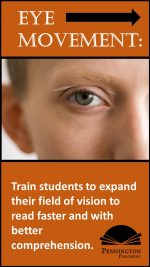How to Scan for Main Ideas
Scanning is an important speed reading technique that all good readers should have in their reading repertoire and works with all modes of writing. Scanning is used to locate specific information for a clearly defined purpose. For example, if a reader needs to know the performance of a particular baseball player in the World Series, it is not necessary to read an entire book on that World Series to find out everything that the one player did in that series. The reader could simply look for the player’s name and read the surrounding sentences or paragraphs that pertain to that player.
Although this sounds like “common sense,” it is actually a learned reading skill. Effective teaching can significantly improve scanning accuracy. Print awareness, knowledge of expository structure, and directed eye movement are the keys to this instruction.
First, readers need to select the key word(s) and possible synonyms to search before they begin to scan. Next, readers must carefully examine what these search items look like. Are they long or short words? Is there a capital? Are there quotation marks or hyphens? Are there noticeable prefixes or suffixes? Readers should then impress the key word(s) into their memories by tracing the letters with their fingers or writing them down. After this, readers should close their eyes and visualize the word(s).
Second, readers should examine the mode of writing and adjust their key word(s) search according to the particular organization of that writing mode. Is it narrative? If so, the organization of the reading passage will normally be chronological and will follow story schema. Chapter titles can also be useful. Is it expository? If so, the organization of the reading passage might be by concept, comparison, cause-effect, or order of importance. The graphics of the text such as subtitles, charts and pictures can narrow the search. Book study helps, including the index, study questions, and the summary, can help pinpoint where information is developed.
Third, readers should run their index finger down the center of each page, using their peripheral vision to search for key word(s) on the left and right sides of each page. How comprehensive the search must be will determine how fast the finger moves. Readers should read the sentence in which the key word(s) appears.
The quality and effectiveness of scanning can be improved with the appropriate use of this speed reading strategy and a good amount of practice. Combined with skimming, scanning can reduce a heavy reading load and still help the reader achieve about 50% reading comprehension.
*****
The Science of Reading Intervention Program
Pennington Publishing provides two reading intervention program options for ages eight–adult. The Teaching Reading Strategies (Intervention Program) is a full-year, 55 minutes per day program which includes both word recognition and language comprehension instructional resources (Google slides and print). The word recognition components feature the easy-to-teach, interactive 5 Daily Google Slide Activities: 1. Phonemic Awareness and Morphology 2. Blending, Segmenting, and Spelling 3. Sounds and Spelling Independent Practice 4. Heart Words Independent Practice 5. The Sam and Friends Phonics Books–decodables 1ith comprehension and word fluency practice for older readers. The program also includes sound boxes and personal sound walls for weekly review. The language comprehension components feature comprehensive vocabulary, reading fluency, reading comprehension, spelling, writing and syntax, syllabication, reading strategies, and game card lessons, worksheets, and activities. Word Recognition × Language Comprehension = Skillful Reading: The Simple View of Reading and the National Reading Panel Big 5.
If you only have time for a half-year (or 30 minutes per day) program, the The Science of Reading Intervention Program features the 5 Daily Google Slide Activities, plus the sound boxes and personal word walls for an effective word recognition program.
PREVIEW TEACHING READING STRATEGIES and THE SCIENCE OF READING INTERVENTION PROGRAM RESOURCES HERE for detailed product description and sample lessons.
Get the SCRIP Comprehension Strategies FREE Resource:
![]()
Get the Diagnostic ELA and Reading Assessments FREE Resource:![]()
Get the Syllable Awareness Assessment FREE Resource:
![]()
Get the Syllable Rules FREE Resource:
![]()
Get the Accent Rules FREE Resource:
![]()
Literacy Centers, Reading, Spelling/Vocabulary, Study Skills


